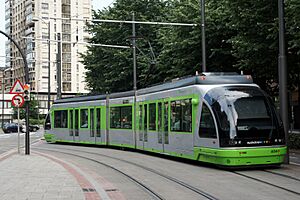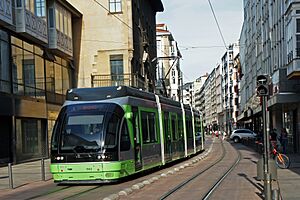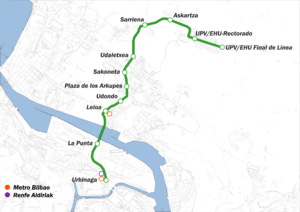Euskotren Tranbia facts for kids
Quick facts for kids Euskotren Tranbia |
|
|---|---|
 Bilbao Euskotran 404.jpg |
|
| Info | |
| Locale | Bilbao, Vitoria-Gasteiz (Basque Country) |
| Transit type | Tram |
| Headquarters |
|
| Operation | |
| Began operation |
|
| Operator(s) | Euskotren |
| Technical | |
| Track gauge | 1,000 mm (3 ft 3 3⁄8 in) metre gauge |
| Electrification | 750 V DC overhead catenary |
Euskotren Tranbia is the name for the tram systems in two cities in the Basque Country, Spain: Vitoria-Gasteiz and Bilbao. These trams help people travel around the cities. The tram system in Bilbao started running in 2002. The one in Vitoria-Gasteiz began operations in 2008. Euskotren Tranbia is part of a larger public transport company called Euskotren. The tracks are narrow, measuring 1000mm wide.
Contents
Tram Services
Euskotren Tranbia runs tram networks in two different provinces. These are Vitoria-Gasteiz in Álava and Bilbao in Biscay. The Bilbao tram system was the first to open in 2002. It was first called EuskoTran. This line connected Bilbao-Atxuri Station with Uribitarte. Over time, the line grew to reach places like the Guggenheim Museum Bilbao and Basurto Hospital.
The tram system in Vitoria-Gasteiz opened in 2008. It has a special Y-shape network. This design allows two different lines to cross the city from south to north. Trams travel on streets, sometimes sharing space with cars. They also have their own special tracks, including some on grassy areas. In some places, trams share lanes with local bus services. These bus services are TUVISA in Vitoria-Gasteiz and Bilbobus in Bilbao.
Tram Stop Design
Each tram system has its own unique stop designs. Some stops are also used by buses. Most stops have low platforms, which makes it easy to get on and off the tram. This is great for people using wheelchairs, prams, or for older passengers. The platforms are almost level with the tram doors. This means there are no steps to climb.
Most stops do not have staff. Instead, they use automatic ticket machines. All stops have screens that show helpful information. You can see the tram network map, the current time, and how often trams arrive. To cross the tracks between platforms, people use special pedestrian crossings. The Bilbao system has 14 stops. The Vitoria-Gasteiz system has 23 stops.
Tram Systems
Bilbao Tram Network
Vitoria-Gasteiz Tram Network
Tickets and Fares
Both tram systems use different types of tickets. You can buy regular paper tickets. You can also use special smartcards like BAT, Barik, and Mugi. There are single-ride tickets, daily tickets, and monthly tickets available. The price for a ticket is the same no matter how far you travel within each network. There are no different "zones" that change the price.
Tram Vehicles
Euskotren Tranbia uses a fleet of 26 CAF Urbos trams. These trams are shared between the Bilbao and Vitoria-Gasteiz networks.
Current Tram Fleet
The 400 series trams are 8 vehicles built for Bilbao. They are about 24.4 meters (80 feet) long. These trams have a low floor for easy access. Each tram can carry up to 196 passengers.
The 500 series trams are 11 vehicles. They were first built for Vitoria-Gasteiz. These trams are about 31.4 meters (103 feet) long. They have 100% low floor access. Each tram can carry up to 261 passengers. Some of these trams are being moved to Bilbao.
The 600 series trams are 7 vehicles built for Vitoria-Gasteiz. They are the longest trams, at about 44.2 meters (145 feet) long. They also have 100% low floor access. These trams can carry up to 398 passengers.
Tram Colors
Trams used to be painted with grey and green stripes. These were the original colors of Euskotren Tranbia. Now, the trams are painted white and green.
Future Plans
Bilbao Tram Future
Vitoria-Gasteiz Tram Future
Past Project Ideas
Sometimes, plans for new tram lines don't happen. Here are a couple of projects that were considered but not built.
Barakaldo Tram Idea
There were ideas to build a tram network in Barakaldo. This tram would have connected to another planned tram line in Leioa. The project included many stops around Barakaldo's city center. However, no progress has been made on this plan since 2010.
Leioa Tram Idea
Plans for a tram in Leioa had two main parts. The first part was building a place to store and fix the trams, along with offices. This part was completed. The second part was building the actual tram line and stops. This line would have gone from the University of the Basque Country campus to downtown Leioa. There was also a third idea to extend the tram across the Estuary of Bilbao. This would have connected Leioa to the Left Bank area. This project was put on hold in 2018.
See also
 In Spanish: Euskotren Tranbia para niños
In Spanish: Euskotren Tranbia para niños
- Euskotren Trena






